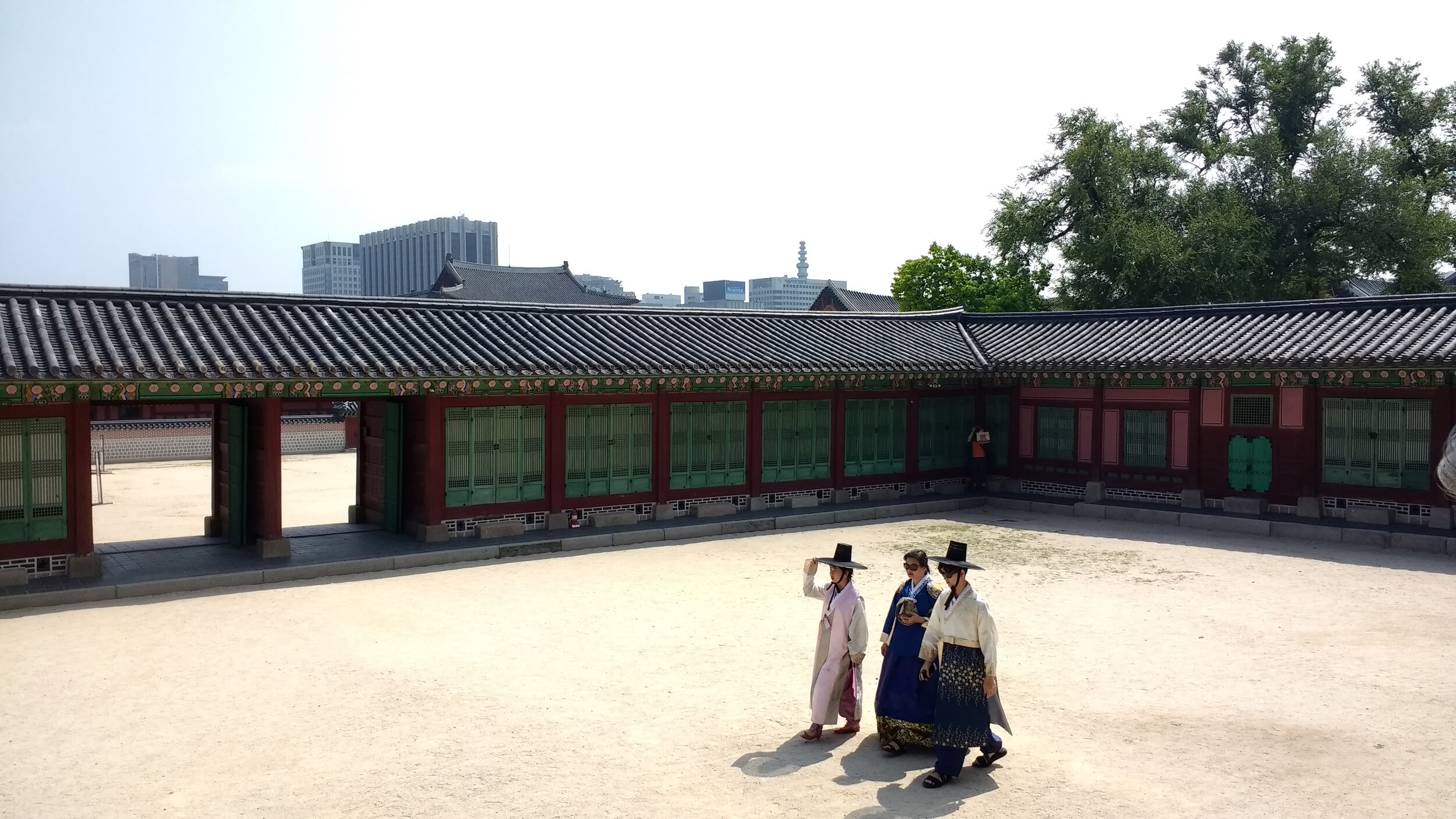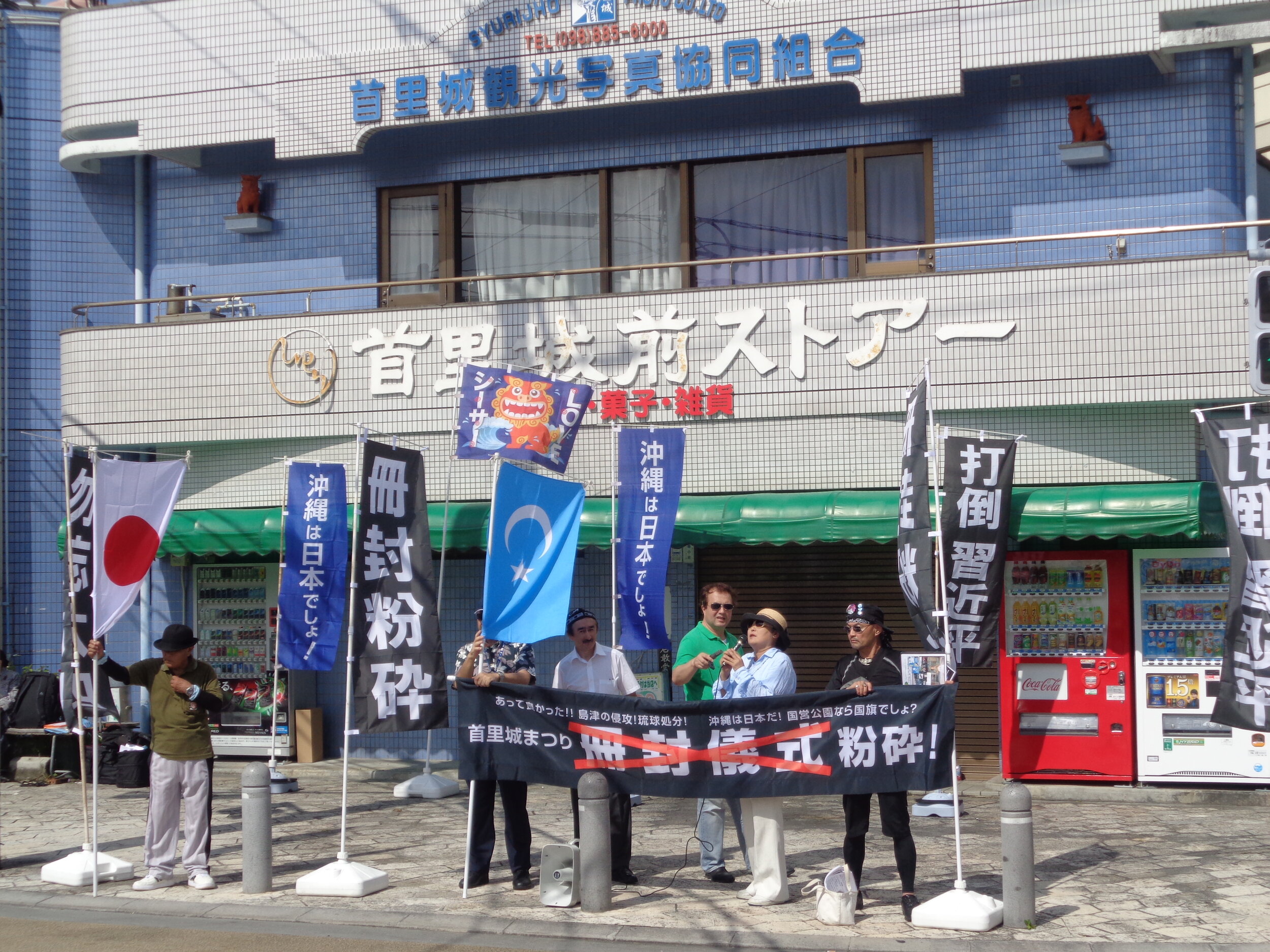
Above: Visitors in traditional Korean hanbok costume at the Gyeongbokgung former royal palace in Seoul, South Korea. Photo my own, June 2017.
East Asian History
For hundreds if not thousands of years, East Asia has been one of the dominant centers of political, economic, and cultural power in the world. In ancient times, China was certainly one of the preeminent “civilizational” centers in the world, with numerous polities throughout the region adopting the written language, political philosophy and culture, governmental structures, and various other aspects of Chinese culture into the very cores of their own. China remained a major political, economic, and cultural center down through the centuries, attracting trade, migration, and other interactions both within the surrounding region, and with distant lands across an extensive if not technically “global” network of overland and maritime Silk Roads, connecting China, Korea, and Japan via Central Asia and the Indian Ocean to cultures as far away as the Roman Empire. In the 16th-18th centuries, Japan was the source of as much as 1/3 of the silver flowing into the global economy; meanwhile, at the same time, roughly 1/3 of the silver mined in the Americas and elsewhere around the world flowed into Chinese coffers. Desire to access East Asian trading routes, and competition over them, were key factors in driving European expansion. By around the year 1700, Beijing and Edo (Tokyo) were the largest cities in the world, with roughly one million people each, dwarfing cities to the west such as Baghdad, Istanbul, Paris, and London.
East Asia was the birthplace of countless inventions and innovations, from pottery and lacquerware to paper, gunpowder, and the compass, to paper money, futures markets, and printing and publishing. The region is also home to myriad vibrant artistic and cultural traditions as well as modern & contemporary art forms, from Chinese calligraphy, ink painting, and poetry to Korean ceramics, drum dance, and pansori storytelling to Japanese tea ceremony, textiles, and Noh and kabuki theatre; from Tibetan architecture and Buddhist thanka paintings to Uyghur meshreps and muqam music; from Okinawan folk song and kumi udui dance-drama to Taiwanese film. From Chinese and North Korean propaganda painting to Hong Kong cinema to the science fiction novels of Liu Cixin and Chen Qiufan; from Japanese butoh theatre, Gutai and Mono-ha art movements to the films of Kurosawa Akira and Ogigami Naoko and the novels of Murakami Haruki and Kawabata Yasunari; from Korean pop idol groups, TV dramas, and film to Ainu rock. East Asia remains, of course, one of the chief centers of political, economic, and cultural power in the world today, with China the 2nd largest economy in the world and South Korea, Japan, and Taiwan not far behind, and Japanese anime, K-pop music, and countless other aspects of East Asian culture attracting considerable popularity the world over.
But “East Asia” is not simply a combination of China, Korea, and Japan. The questions that history seeks to answer - questions about how we got where we are today, questions about cultural products such as architecture, artworks, and music, and questions about interesting or influential events in the past - pertain to the Ainu, Ryukyu, Taiwan, Hong Kong, Mongolia, East Turkestan, and Tibet as well. These places also have history and culture worth exploring; they also have stories that are important to learn and to tell.
As we discuss the ancient origins and premodern development of the numerous rising and falling kingdoms and dynasties in the Chinese mainland, the Three Kingdoms which later gave way to one on the Korean peninsula, and successive weakly centralized states in the Japanese islands which eventually gave way to a unified modern nation-state, we can also look at polities such as the Xixia, Jin, and Liao kingdoms of the Tangut, Jurchen, and Khitan peoples who the Han Chinese called “barbarians,” and at the prominent role of Central Asian and other foreign cultures in the Tang, Yuan, and Qing dynasties, and ask ourselves what exactly is meant by “China” or “Chinese culture.” And we can consider the peoples of East Turkestan, Tibet, Taiwan, the Ryukyu Islands, and Ainu communities, expanding our notion of “East Asia,” and complicating our understandings of “Korea” and “Japan” as supposedly singular or homogeneous entities. Over the course of the last 2,000 years, numerous regimes have risen and fallen across East Asia; the regions we today call “the Chinese mainland,” “the Korean peninsula,” and “the Japanese islands” were, at times, sometimes for centuries, divided into multiple different polities – decentralized, and with other peoples on their frontiers. China was at times fragmented into tens of kingdoms, some ruled by ethnic groups other than the Han Chinese; Korea, similarly, consisted of three kingdoms before it was ever united under one; and the Japanese islands, though ostensibly under a single emperor for much of the last 1500 years or so, were in fact more often ruled by relatively weak central governments and by a multitude of regional and local powers. In the processes of unifying and expanding, Chinese, Korean, Japanese, and Ryukyuan polities - among others - absorbed, eliminated, or pushed out other peoples. Territories grew, shifted, and shrank, and regimes rose and fell, ruled over by “kingdoms” and “empires” that operated according to rather different assumptions and beliefs from European or modern understandings of “nation,” “ethnicity,” and citizenship or subjecthood (i.e. “belonging”), as well as of “empire.” These native East Asian conceptions shifted and developed over the centuries, eventually encountering Western norms in a clash which reached its climax in the mid-to-late 19th century.
The shift to “modernity” in the late 19th and early 20th centuries brought with it not only great reforms and revolutions, war and colonial oppression, but also conceptual and cultural challenges across countless aspects of society. Even as such concepts were far from fixed within the West, East Asia was forced to engage with Western norms, and adopted new understandings of everything from “science” to “religion” to “art.” In exploring what each of these meant traditionally in East Asia and what they came to mean in the late 19th to early 20th centuries, we can touch upon the inventions of “national” arts and traditions, and the defining and re-defining of “China,” “Korea,” and “Japan.”
Exploring the revolutions and other great shifts of the 19th-20th centuries, the rise and fall of the Empire of Japan, the Nationalist and Communist revolutions in China, their takeovers of Korea, Taiwan, the Ryukyus, and beyond, the independence and division of Korea, and other developments in each of these areas in the 70+ years since the end of World War II, we can continue to talk about how concepts such as nation, national identity, and nationalism; race and ethnicity; tradition and modernity; and empire and colonialism played out (and continue to play out) across the region, and how East Asian history might inform our understandings of those concepts more broadly. Doing so allows not only for an expanded or deepened understanding of East Asia in particular - a body of knowledge valuable to us as informed citizens engaged in business, politics, travel, or even just pop culture - but also for valuable opportunities to reconsider our assumptions and understandings about our own histories, cultures, and identities.
Below: The complexities of politics in the region seen in a group of Japanese and Uyghurs protesting against the People’s Republic of China government’s treatment of Uyghurs, Tibetans, and others, and against Okinawan celebrations of the Ryukyu Kingdom’s association with the Qing dynasty which emphasize Okinawans’ own distinctive history and culture, outside of Shuri castle, the former Ryukyu royal palace, October 2016. Photo my own.
